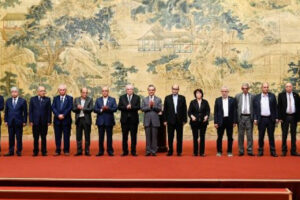From a young age, DOCG was taught he should become a doctor, lawyer or engineer.
Born to Sri Lankan immigrants, the Melbourne-based artist — who wants to go by his artist name, DOCG — said his cultural upbringing never gave him room to explore other career paths.
Like many Asian-Australian migrants, DOCG’s parents wanted him to chose a stable, high-paying profession.
“All my cousins were becoming engineers and doctors,” he told the ABC.
But as DOCG grew up, he realised that he did not like the expectations of what he was meant to do with his career, and wanted to carve his own identity as an artist.
“Finding out you could become a designer, graphic designer or a photographer were intriguing to me because they were so unknown,” DOCG said.
“I’ve never seen someone have that kind of career path, especially in our culture.”
After seven years working as a creative director, stylist, artist and photographer, DOCG has collaborated and worked with big brands including Platypus, Adidas, Reebok and New Balance.
He said his parents were initially confused by his artistic career path.
“They just looked at themselves, like what did they do wrong,” DOCG said.
“They were like, ‘Where did this come from, who were your friends, who have you been listening to, we never taught you this.'”
However, DOCG said that as he grew older, he began to have “a lot of empathy and understanding” for his parents’ reasoning for wanting him to pursue a different career.
He said the culture had taught people, like his parents, that only those with professional jobs could make a living.
DOCG said people who grew up in a developing country would also have different views on art and design compared to those from a Western culture.
“[My parents] were unaware of how important art and design is in Western society,” he said.
Having designed and released everything from clothes and jewellery to hosting international shows and exhibitions, DOCG said he enjoyed the sense of expression and freedom of doing something he loves.
“I’d rather be unbounded from social norms and build my own path than to follow a template that was provided to me when I was a kid,” he said.
And although the artist did not become a doctor, the creation of his moniker “DOCG”, allowed him to turn this cultural expectation into a name that he has made on his own.
“I just want to have fun. I want to be able to make things and hope that when people see what I make as an individual, they become inspired to do that for themselves,” he said.
“I want to expand, grow and evolve — and I hope that’s what the future for others will look like.”
‘Staying true to yourself’
Many Australians from Asian backgrounds have reported experiencing cultural and social barriers when choosing a career in the art industry.
Diversity Arts Australia chief executive Lena Nahlous said Australia’s art and cultural practices were deeply rooted in the Euro-American model, which could exclude many migrants.
Ms Nahlous said they were often unable to access funding, not recognised for the work they produced and had limited access to opportunities and work.
Many were also under-represented and “historically excluded and marginalised” in these workplaces, she said.
Research from Diversity Arts Australia revealed that only 9 per cent of the 1,980 leaders of the country’s institutions are culturally and linguistically diverse (CALD) Australians, even though the Australian Human Rights Commission found 39 per cent of the Australian population have a CALD background.
“Research tells us that culturally diverse people have struggled to find work in the sector and that there is an over-representation of people from Anglo-Celtic backgrounds in the arts, screen and creative sectors,” Ms Nahlous said.
“Calling-out and countering this exclusion and opening pathways into the funded or mainstream creative industries for historically excluded people is critical to our work at Diversity Arts Australia.”
The under-representation of CALD Australians in creative roles has discouraged many aspiring Asian-Australian artists from pursuing a career in the industry.
But Asian-Australian artists like musician Grant Perez say it’s time for that to change.
Perez, who is also known as grentperez, is a Sydney-based musician who has performed across Australia and in Europe and the United States.
The indie pop artist has more than 2 million monthly listeners on Spotify and has released his latest EP, When We Were Younger, earlier this month.
When asked about his musical journey, Perez told ABC News that he did not think people like him could succeed in the industry.
“Growing up, I was just unaware of other Asian-Australian artists. I think I wasn’t presented enough with it compared to the Western American pop music scene,” Perez said.
“I always thought that it was so interesting because other than Bruno Mars and people from the Philippines, I haven’t really seen people like me out there when I was younger.”
Despite this, Perez never gave up on his dream.
“I am a big believer of staying true to yourself,” Perez said.
“And I always pictured myself performing on stage and singing stuff that I made in front of people.”
And with the success of his YouTube covers and debut single, Cherry Wine, Perez believed he could impact communities as a young Filipino artist.
“I really try to convey the message of being yourself because that’s what makes you unique,” Perez said.
“It makes me really happy to see more Asian people come into the industry — that’s a big motivator.
“I just tell them to just go for it because there’s nothing stopping you.”
‘Steer the boat to where you want it to go’
Many first-generation migrants who worked in industries such as IT, medicine and accounting in their home countries had to chose lower qualification jobs in Australia to meet visa requirements, according to Nick Parr, professor of demography at Macquarie University.
Those migrants would often encourage their children to pursue the professions they originally had back home, but their children have more freedom to chose what they want to do, Professor Parr said.
“It has been suggested that parents from Asian countries have tried to influence their children’s choice of degree programs, educational qualifications and occupations,” he said.
“[Their children] don’t have the same constraints on their choice of occupation as opposed to their parents’ generation.
“It shouldn’t be surprising if there is more diversity in occupations.”
Melbourne-based photographer Luisa Brimble said at one point in her career, she was pressured to become a nurse.
She then studied banking and finance at college for two years in the Philippines before migrating to Australia with her family, and eventually worked in marketing.
However, when Brimble decided to pick up her old DSLR camera and started taking photos of her family and friends, she quickly realised that photography was her passion and left her marketing job of 10 years.
As a food photographer for more than 15 years, Brimble has worked with leading publishing houses including Penguin Random House and Hardie Grant Publishing, and was a James Beard nominated photographer in 2019.
Brimble told the ABC that sometimes people did not listen enough to what they love to do.
“It’s a much different generation [now] because we don’t have the pressure to be a person [working] in the stock exchange or nursing — you don’t have to wait for others to tell you,” Brimble said.
“You can do things on your own.”
Source: ABC















